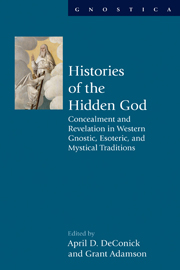 Histories of the Hidden God
Histories of the Hidden God A GOD AT ONCE KNOWN AND UNKNOWN
In Western religious traditions, God is conventionally conceived to be a humanlike creator, lawgiver, and king. In the Hebrew bible, he is not pictured as an incorporeal deity. Rather he has a form – a tselem and a demut – that is humanlike. He possesses body parts: a face, hands, ears, mouth, fingers and feet. He is enthroned in the highest heaven and rules the universe from his celestial temple. So in the scriptures he is lauded as the God of the Heavens. He is the astral Lord, known as the god whose throne is heaven and whose footstool is the earth. He talks to the Israelites out of the heavens and his luminous embodied image, the kavod, can be seen in heaven by visionaries like Ezekiel.
His heavenly presence, however, is not the whole story. This is a god who also was believed to have a physical presence in the sky and on earth. He is the god who manifests himself in the cosmos, riding on the clouds, whose appearances or theophanies are accompanied by thunder, lightning, rain, and earthquake. In the biblical literature, the temple – the replica of his heavenly station – was believed to house God's presence in Jerusalem, although its limited size was such that it could barely contain the fringes of his mantle.
To save this book to your Kindle, first ensure [email protected] is added to your Approved Personal Document E-mail List under your Personal Document Settings on the Manage Your Content and Devices page of your Amazon account. Then enter the ‘name’ part of your Kindle email address below. Find out more about saving to your Kindle.
Note you can select to save to either the @free.kindle.com or @kindle.com variations. ‘@free.kindle.com’ emails are free but can only be saved to your device when it is connected to wi-fi. ‘@kindle.com’ emails can be delivered even when you are not connected to wi-fi, but note that service fees apply.
Find out more about the Kindle Personal Document Service.
To save content items to your account, please confirm that you agree to abide by our usage policies. If this is the first time you use this feature, you will be asked to authorise Cambridge Core to connect with your account. Find out more about saving content to Dropbox.
To save content items to your account, please confirm that you agree to abide by our usage policies. If this is the first time you use this feature, you will be asked to authorise Cambridge Core to connect with your account. Find out more about saving content to Google Drive.